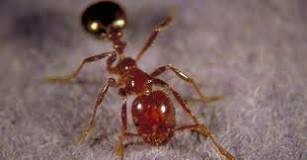Study Says that Wildlife Corridors May Be Responsible for Spread of Invasive Species
| Marco Foronda | | Aug 07, 2014 05:18 PM EDT |
(Photo : http://fireant.tamu.edu/)
A new study suggests wildlife corridors encourage the propagation of invasive species.
Wildlife corridors are areas of habitat that connect wildlife populations and separate animals from human activities or structures.
Invasive species refers to flora and fauna that are harmful to the economy, health and the environment.
Like Us on Facebook
Conducted by University of Florida researchers led by Julian Resasco, the study sought to discover the reasons why some invasive species benefit from the corridors and others don't.
Researchers described the situation of wildlife corridors and invasive species as a "a classic example of unintended consequences."
Florida has been experiencing problems related to invasive species. It's being invaded by non-indigenous animals such as feral hogs, Burmese pythons, green iguanas and ever tree frogs.
Researchers from the University of Florida explored eight sites for the study, each site about the size of football field. Some sites are connected to the corridors and some are not.
Each site is dominated by one or two types of fire ants.
Resasco and other researchers were quite surprised because the results display the incredible skills of invasive species in conquering new areas without the help of corridors.
There are two kinds of fire ants: monogyne ants fly in order to disperse while polygyne ants are ground crawlers.
Monogyne ants scatter into the air to form new colonies while polygyne ants mate in the ground and crawl short distances ground to add colonies.
Monogyne ants quickly spread compared to polygyne ants.
The researchers found out that polygyne ants used the corridors wisely to spread more quickly. Areas colonized by polygyne ants in the connected areas have a lower native ant diversity compared to unconnected ones.
The spread of invasive species via wildlife corridors depend on the ability of species to disperse, said Resasco.
"It is not a coincidence that the readily dispersing monogyne form of fire ants doesn't benefit from corridors, whereas the poorly dispersing polygyne form does," Resasco added.
Further studies are required to find out the real effects of wildlife corridors on the spread of invasive species.
TagsMonogyne, Polygyne, Fire Ants, invasive species, Wildlife corridors, Science, flora and fauna, University of Florida, science research
©2015 Chinatopix All rights reserved. Do not reproduce without permission
EDITOR'S PICKS
-

Did the Trump administration just announce plans for a trade war with ‘hostile’ China and Russia?
-

US Senate passes Taiwan travel bill slammed by China
-

As Yan Sihong’s family grieves, here are other Chinese students who went missing abroad. Some have never been found
-

Beijing blasts Western critics who ‘smear China’ with the term sharp power
-

China Envoy Seeks to Defuse Tensions With U.S. as a Trade War Brews
-

Singapore's Deputy PM Provides Bitcoin Vote of Confidence Amid China's Blanket Bans
-

China warns investors over risks in overseas virtual currency trading
-

Chinese government most trustworthy: survey
-

Kashima Antlers On Course For Back-To-Back Titles
MOST POPULAR
LATEST NEWS
Zhou Yongkang: China's Former Security Chief Sentenced to Life in Prison

China's former Chief of the Ministry of Public Security, Zhou Yongkang, has been given a life sentence after he was found guilty of abusing his office, bribery and deliberately ... Full Article
TRENDING STORY

China Pork Prices Expected to Stabilize As The Supplies Recover

Elephone P9000 Smartphone is now on Sale on Amazon India

There's a Big Chance Cliffhangers Won't Still Be Resolved When Grey's Anatomy Season 13 Returns

Supreme Court Ruled on Samsung vs Apple Dispute for Patent Infringement

Microsoft Surface Pro 5 Rumors and Release Date: What is the Latest?










